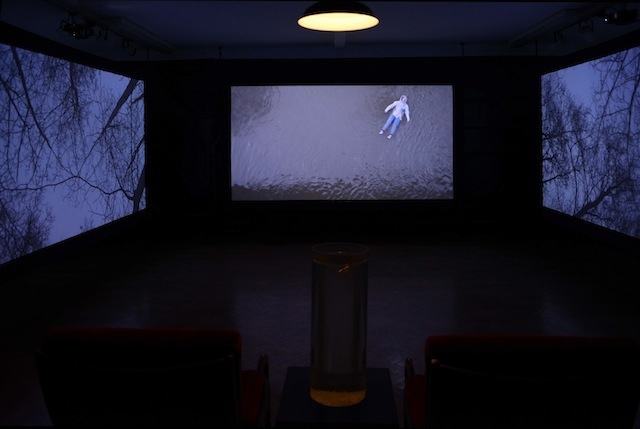There’s a man walking along a beach, his metal-detector swaying gently from side to side following an invisible current, pulling him this way and that across sandy saltwater rivulets. He’s talking about eels. They come from Sargasso Sea. The eels travel over 3,000 miles to get to Europe, where they begin their transmutation from saltwater to freshwater fish. They change colour from glass-clear to silver-grey. Shown for the first time at Whitstable Biennale, Webb-Ellis’s three-channel video installation Parlor Walls (2016) is set in the north-western coastal town of Whitby, Yorkshire, and explores the idea of connections in a digitised age between people, nature, and the Internet. Alongside the story of eel migration, and inspired by the dystopian ideas in Ray Bradbury’s novel Farenheit 451 (1953), the screens switch intermittently between clips of white clowns swinging a skipping rope over a brook, its centripetal force pulling you forward, YouTube videos made to induce an autonomous sensory meridian response (ASMR) and figures dressed in silver-foiled survival jackets. Bradbury’s influence echoes in the surrounding three ‘television walls’: the YouTubers’ caresses against the screen, intending to leave static tingling on the skin, offer artificial comfort. Facing the screens are two old cinema chairs separated by a tall cylindrical aquarium, in which a single little fish flutters inside, a symbol of isolation. But the overall effect, hypnotically compelling, delivers the message: you are here, you are not alone.
This year, the theme of Kent coast’s Whitstable Biennale, The Faraway Nearby is about distance. It’s about travel, search, exploration, migration. And it’s about making somewhere home, wherever that might be. In her letters from New Mexico to New York (to which the title makes reference) artist Georgia O’Keeffe often wrote about the sensation of belonging to a landscape that was totally unfamiliar and at the same time, close at heart. Now in its eighth edition, Whitstable Biennale’s programme of performances, film screenings and sound pieces have embedded this theme into the community itself: the artworks can be found in the library, florist, ice cream shop and harbour beach huts.
Marcia Farquhar has collaborated with local ice cream parlour Sundae Sundae to create a new flavour especially for the Biennale, Rooty Tooty (made from sarsaparilla), and her short film Based on a true story involving my mother, myself, an unknown old couple, a green ice cream and a hedge (2016) plays in the parlour’s window, paying homage to the saucy seaside postcard. Richard Layzell can be found guerrilla gardening across the town in his site-specific performance piece Softly Softly (2015), where participants can also discover the underground history of Whitstable at Gorrell Tank Car Park and are encouraged to assist with teddy bear catapulting outside the medical centre.
The works that root the Biennale in its seaside location offer a firm (if eccentric) ground upon which the festival can continue a rhizomic exploration of a theme that reaches out towards other lands and other cultures.
The works that root the Biennale in its seaside location offer a firm (if eccentric) ground upon which the festival can continue a rhizomic exploration of a theme that reaches out towards other lands and other cultures. Island (2015), a film by Becca Voelcker, presents the everyday life of a family on the remote sub-tropical Japanese island of Ishigaki, Okinawa Prefecture, following children’s pageants, traditional dance classes and tea ceremonies. These scenes show a different culture, but one that shares a common sentiment: that of belonging to something, to somewhere.
Ideas of tradition, history, change and uncertainty come together in Sarah Wood’s Boat People (2016), an essay film in ten parts. Wood uses the form of moving image to explore the movement and migration, of humans, where the perception of what is near or far away can be manipulated by the digital image. While you sit on a low wooden box in a dark shed, staring into a screen, a voice says to you, “Welcome.” It says, “Sea monsters flail and snarl… the sea goes still. That was then.” And continues, “We set the table, we open the doors to our home… Revelation comes from the generosity of a welcome. Welcome.”
In recent years, Kent County Council has seen more than 1,500 unaccompanied child refugees reach its shores having fled countries razed by conflict, just 40 of whom were temporarily housed in Whitstable’s former Ladesfield Care Home in 2015. The home closed in January this year. Whitstable Biennale’s approach towards the current issues of migration is handled sensitively (both for refugees escaping conflict and Kent residents) by presenting works that evoke varying senses of homeliness and comfort, loneliness and displacement.
Whitstable Biennale continues through 12 June 2016.
8 June 2016
